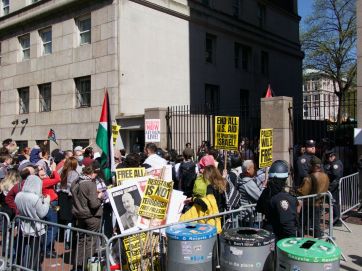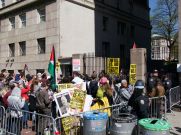NAS member J. Martin Rochester, Curators’ Teaching Professor of political science at University of Missouri-St. Louis, has written a case study of the 2015 crisis at the University of Missouri, using it as a window into the declining commitment to diversity, free speech, and academic rigor nationwide.
As a University of Missouri (UM) faculty member, I watched with a mixture of amazement and horror at the events that unfolded during the 2015-16 academic year. Amazement, because perhaps never before had so few students been able to get so many college administrators to display so much cowardice over so little provocation. A relatively small group of protestors not only succeeded in ousting the two highest officials in the UM system but also emboldened the radical left all across the country to hold campuses hostage to threats of disruption, in a chain reaction that eventually encompassed both elite private universities and large public institutions.1 Horror, because perhaps never before had we seen quite this combination of jackbooted intolerance and sophomorism at work in higher education.
The 1960s also saw campus demonstrations of a significant magnitude, but they at least could be understood as reactions to the vilest forms of racism, along with anger over the Vietnam War. Although there remain legitimate concerns about racial and social justice today, we clearly live in a much more inclusive society—and there is no major war taking the lives of tens of thousands of Americans. Chants about white supremacy and white oppression seem somewhat misplaced at a time when Asians are the most educationally and economically successful racial group in America, a black man was twice elected by comfortable majorities to occupy the highest office in the land, and two of the last five secretaries of state were also black. On most measures of racial progress, improvement has been unmistakable.
Closer to home, beyond some anecdotes, it is hard to validate the complaints of Mizzou students that the campus suffers from a climate of racism. Nobody has taken a reliable survey of the racial attitudes of the 35,000 students in Columbia. And it is difficult to square the accusation of a “climate of racism” with the fact that UM President Tim Wolfe was preceded by the black Elson Floyd; that the president and the homecoming queen of the UM-Columbia student body at the time of the crisis were both black; that the black graduate student whose hunger strike against “white privilege” led to the climatic events of November 9 was the son of a millionaire railroad executive; that representation of African-Americans in the undergraduate student body (8.1 percent) and among tenure-track faculty (3.5 percent) roughly approximated the level of representation in American universities generally; and that two months before the crisis the university had held a diversity workshop educating faculty and staff in the use of racially acceptable language.2
My own campus, UM-St. Louis (UMSL), has not escaped the fallout from its sister campus, as diversity sensitivity training has been stepped up here as well. It does not matter that UMSL has among the most diverse minority student populations in the state, with blacks comprising 18 percent of the student body; that in my department alone one-third of the tenure-track faculty are black; that there has been a “cultural diversity” curriculum requirement for all majors for decades; that we have had a black chancellor, at a time we were called a “racist” institution; that we have long had a “chief diversity officer” and a “chancellor’s diversity council”; and that as recently as 2013 we received a national “Higher Education Excellence in Diversity” award.
Universities have come a long way since Kent State and other symbols of Vietnam-era activism, but one would never know it from the shrillness of voices being heard today in the halls of academe. Many have attributed the growing shrillness to Trump-era hyper-polarization, although the Mizzou protest, and many other such episodes, preceded Trump’s election. Whether in Columbia, St. Louis, or any other community, the local campus is probably the single most diverse place in town, yet the site of the largest grievance industry over racism, sexism, classism, and other categories of victimhood and discrimination. We are in the midst of a revolution of rising expectations.3 Students may have less reason to be enraged today than in the 1960s, but the growth of political correctness, social media, and other cultural trends over the past fifty years has only increased the sense of entitlement and the level of revolutionary fervor, stoking student demands that go far beyond anything conceivable in the past. There is a take-no-prisoners quality to the current uprising.
One could see this not only in the Mizzou affair but also in the campus follies it helped trigger nationwide. For example, almost no one in the 1960s at Princeton would have dared suggest the removal of Woodrow Wilson’s name from the School of International and Public Affairs and other corners of the campus, lest they reveal ignorance of the fact they were calling for expunging an iconic figure long considered the father of American progressivism and the liberal welfare state, as well as the exemplar of liberal internationalism through his creation of the League of Nations. Yet, when students staged a sit-in at President Eisgruber’s office in November 2015, they demanded Wilson’s banishment from campus due to his “racist legacy.” The students settled for the removal of his mural, along with a ban on the title “masters” of residential colleges.
A month earlier, Yale experienced a similar uproar over a memo circulated by its Intercultural Affairs Council instructing students in proper Halloween attire, and urging them not to wear costumes (say, Mexican garb) that might border on “cultural appropriation.” Erika Christakis, a lecturer in early childhood education and the wife of the head of a residential college, elicited a storm of profanity from irate students who called for her dismissal when she replied in a public email that Yalies were capable of making their own Halloween costume selections. Yale President Salovey said he heard the student protestors’ “cries for help” and accepted Christakis’ resignation—an action which indicated just how scary the ivory tower had become. Around that same time, not to be outdone, Columbia University saw several hundred students gather on the quadrangle to chant “I love black criminals,” extending the same warm welcome the school had given Iranian president and Holocaust denier Mahmoud Ahmadinejad a few years earlier. One was left wondering what kind of reception someone on the opposite end of the ideological spectrum would likely get—a Ben Carson, a David Clarke—were he ever invited to speak there.
One final illustration of the depths to which higher education had descended: the students at Lebanon Valley College in Pennsylvania matched the silliness of their Ivy League counterparts when they demanded the renaming of Lynch Hall. In doing so, they dishonored a former college president—and raised the possibility that former U.S. Attorney-General Loretta Lynch might not be considered as a commencement speaker anytime in the future.
If the Mizzou case seems a caricature of contemporary American academia, it is by less than six degrees of separation.
NOTES
- Wong and Green estimate that some sixty colleges and universities were the subject of “demands” made by student protestors during 2015-2016. Although some of these protest events preceded the Mizzou crisis, for many others the crisis was a catalyst. See Alia Wong and Adrienne Green, “Campus Politics: A Cheat Sheet,” Atlantic, March 4, 2016, https://www.theatlantic.com/education/archive/2016/04/campus-protest-roundup/417570/.
- For statistics on the racial composition of the Mizzou campus and the degree to which discrimination exists, see Michael Podgursky, “Racial Discord and Response at the University of Missouri-Columbia,” talk given at the Discussion Club, St. Louis, May 6, 2016.
- On revolutions of rising expectations, see W.C. Runciman, Relative Deprivation and Social Justice (Berkeley: University of California Press, 1966); and Russell K. Nieli, “Snowflake Jacobins: Black Rage on Campus,” Academic Questions, 29 (Summer 2016): 163-176.
Image: CAFNR Summer Academy_Mizzou Arena_07152014_0001 by CAFNR // CC BY-NC 2.0













